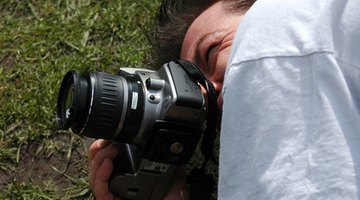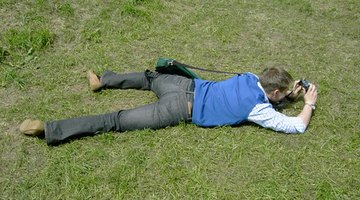Whether you realise it or not, every photograph has a viewpoint. Viewpoint is defined as the angle, direction or stance from which you choose to shoot each image. While shooting from a standing position is most commonly used (especially by beginning photographers), exploring other options or ways of seeing your subject can invigorate your work.
Slow Down

Slow down and test multiple viewpoints when taking pictures. Too many people quickly press the shutter button and move on to the next subject. While this might be acceptable for everyday snapshots, taking your time to find the best perspective and composition can result in striking photos.
Possible Viewpoints

Experiment in selecting the perspective which best highlights your subject. For example, if photographing a group of friends seated around a dinner table, try standing on a chair and looking down on the scene. (An added benefit is that your unexpected behaviour might loosen up the group, making them more at ease in front of the camera.) When capturing images of children, photographer Scott Kelby says, "The trick is to shoot from their level--get down on one knee, or sit on the floor, to capture them from a viewpoint we normally don't see." For another unique approach, attempt some pictures while lying on your back. Although you might feel self-conscious, just remind yourself that an unusual viewpoint can equate to creating pictures with major dazzle.
- Experiment in selecting the perspective which best highlights your subject.
- When capturing images of children, photographer Scott Kelby says, "The trick is to shoot from their level--get down on one knee, or sit on the floor, to capture them from a viewpoint we normally don't see."
Simplicity

Declutter your photographs. In slowing down and exploring various viewpoints, you will benefit by selecting an angle which avoids distracting objects. Every item in successful images has a purpose. If there's a scraggly branch on the periphery of your picture, you can remove the offender by changing your viewpoint.
- Declutter your photographs.
- If there's a scraggly branch on the periphery of your picture, you can remove the offender by changing your viewpoint.
Tilt Your Camera

Tilt your camera slightly for a novel perspective. In most shots, a horizontal horizon is recommended. However, viewpoint is all about capturing something a little out of the ordinary. Remember, though, a little goes a long way and an overly dramatic tilt could be disorienting.
- Tilt your camera slightly for a novel perspective.
Lenses

Change lenses to further enhance your viewpoint. Whether working with a single-lens reflex or a "point and shoot" camera, try standing on a ladder (or lying on your back) and shooting with your widest available focal length (or lens). The distortion will be powerful and can add dynamic interest to the photo.
Creating Style

Select various photo assignments for yourself and practice shooting from multiple viewpoints. The experience you amass could result in helping create your own extraordinary style--something to which all serious photographers aspire.
